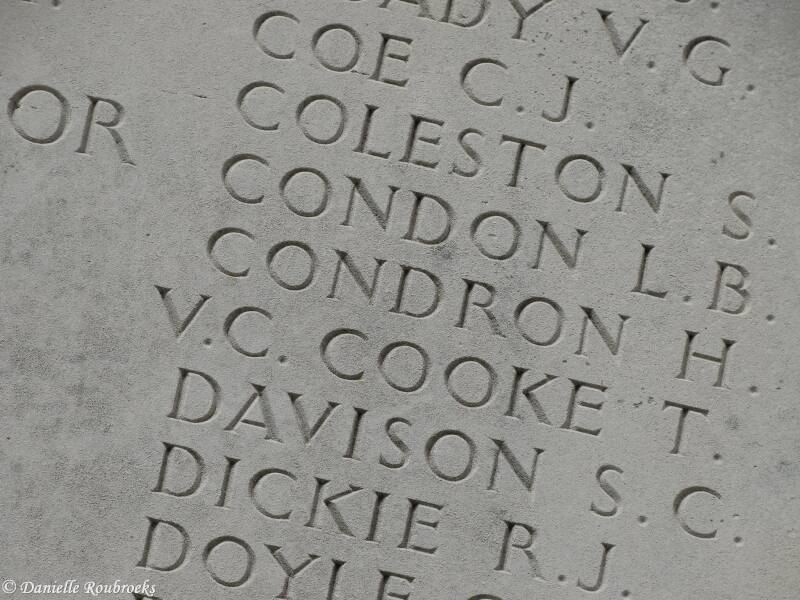Villers-Bretonneux Military Cemetery and Memorial
Historical Information (Source: CWGC)
Villers-Bretonneux Military Cemetery was made after the Armistice when graves were brought in from other burial grounds in the area and from the battlefields. Plots I to XX were completed by 1920 and contain mostly Australian graves, almost all from the period March to August 1918. Plots IIIA, VIA, XIIIA and XVIA, and Rows in other Plots lettered AA, were completed by 1925, and contain a much larger proportion of unidentified graves brought from a wider area. Later, 444 graves were brought in from Dury Hospital Military Cemetery.
There are now more than 2,100 Commonwealth servicemen of the First World War buried or commemorated in this cemetery. 608 of the burials are unidentified but there are special memorials to five casualties known or believed to be buried among them, and to 15 buried in other cemeteries whose graves could not be found on concentration. The cemetery also contains the graves of two New Zealand airmen of the Second World War.
Served with
- Australian (735)
- United Kingdom (557)
- Canadian (254)
- New Zealand (2)
- South African (1)
Served in
- Army (1516)
- Air Force (33)
The memorial is the Australian National Memorial erected to commemorate all Australian soldiers who fought in France and Belgium during the First World War, to their dead, and especially to name those of the dead whose graves are not known. The Australian servicemen named on this memorial died on the battlefields of the Somme 1916-18, Pozieres, Bapaume 1917, Arras 1917, Bullecourt, Messines 1917, Ypres 1917, Menin Road, Polygon Wood, Broodseinde, Poelcappelle, Passchendaele, Avre, Ancre 1918, Villers-Bretonneux, Lys, Hazebrouck, Hamel, Marne 1918, Amiens, Albert 1918, Albert 1918 (Chuignes), Mont-St. Quentin, Hindenburg Line, Epehy, St. Quentin Canal and Beaurevoir. Both the cemetery and memorial were designed by Sir Edwin Lutyens.
The memorial was unveiled by King George VI on 22 July 1938. Of the 10,982 names displayed at the unveiling of the Villers-Bretonneux Memorial the burial places of many have since been identified and this continues to this day. As a result, there are currently 10,729 Australian servicemen officially commemorated by this memorial.
Served with
- Australian (10712)
- United Kingdom (99)
Served in
- Army (10811)
VICTORIA CROSS
Private Thomas COOKE - 3055 - 8th Bn. Australian Infantry, A.I.F.
Died 28 July 1916 Age 35
Country of Service: Australian
Awards: Victoria Cross
Citation
An extract from "The London Gazette," dated 8th Sept., 1916, records the following:- "For most conspicuous bravery. After a Lewis gun had been disabled, he was ordered to take his gun and gun-team to a dangerous part of the line. Here he did fine work, but came under very heavy fire, with the result that finally he was the only man left. He still stuck to his post, and continued to fire his gun. When assistance was sent he was found dead beside his gun. He set a splendid example of determination and devotion to duty."
(Source: Wikipedia)
Lieutenant John BRILLANT - 22nd Bn. Canadian Infantry
Died 10 August 1918 Age 28
Country of Service: Canadian
Awards: Victoria Cross, Military Cross
Citation
An extract from "The London Gazette" No. 30922, dated 27th Sept., 1918, records the following:-"For most conspicuous bravery and outstanding devotion to duty when in charge of a company which he led in attack during two days with absolute fearlessness and extraordinary ability and initiative, the extent of the advance being twelve miles. On the first day of operations shortly after the attack had begun, his company's left flank was held up by an enemy machine gun. Lt. Brillant rushed and captured the machine-gun, personally killing two of the enemy crew. Whilst doing this, he was wounded but refused to leave his command. Later on the same day, his company was held up by heavy machine-gun fire. He reconnoitred the ground personally, organised a party of two platoons and rushed straight for the machine-gun nest. Here 150 enemy and fifteen machine-guns were captured. Lt. Brillant personally killing five of the enemy, and being wounded a second time. He had this wound dressed immediately, and again refused to leave his company. Subsequently this gallant officer detected a field gun firing on his men over open sights. He immediately organised and led a "rushing" party towards the gun. After progressing about 600 yards, he was again seriously wounded. In spite of this third wound, he continued to advance for some 200 yards more, when he fell unconscious from exhaustion and loss of blood. Lt. Brillant's wonderful example throughout the day inspired his men with an enthusiasm and dash which largely contributed towards the success of the operations."
Grave Reference: VIA. B. 20.
(Source: Wikipedia)





























































